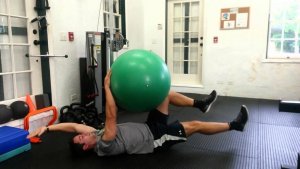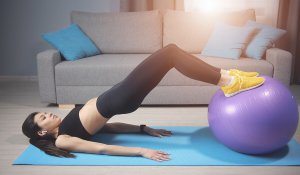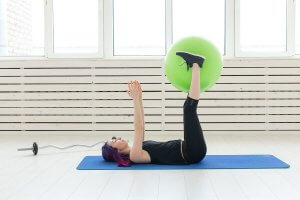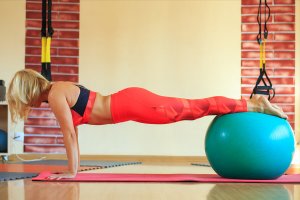Strengthen Your Core With a Swiss Ball

Using stability training equipment, such as a Swiss Ball can be great for working your core. Swiss Balls are mainly used as an effective alternative to crunches to strengthen the abs.
Suggested exercises with a Swiss Ball
Below, we’ve detailed how to do some useful exercises with a Swiss Ball to strengthen your abs. Take note and try them out!
1. Forward roll
Starting position:
- Kneel down on the floor in front of the Swiss Ball.
- Rest your hands and forearms on the side of the ball which is closest to you.
- Maintaining your hips at a right angle, shift your body weight onto your forearms, working the glutes and abdomen.
- Your body should move as a single unit, from the shoulders to the knees, as though the hip joint didn’t exist, maintaining a fixed shape through the exercise.

Eccentric phase:
- Keeping your shape, rock your body forward, moving all the weight onto the Swiss Ball.
- Next, roll the ball forward, sliding your forearms on it.
Concentric phase:
- Bring your forearms back and roll your body weight back to return to the starting position without flexing your hips.
- It’s important that you shouldn’t flex your hips at any point. They should stay completely fixed.
2. Dead bug exercise with legs and arms outstretched
Starting position:
- Lie on your back and place the Swiss Ball between your hands and legs.
- Keep your knees and arms raised.
- The most important thing is to keep your hips in position and avoid your lower back coming off the floor. Otherwise, you could injure your lower back and the exercise will do more harm than good.
Eccentric phase:
- Lift one arm and the opposite leg away from the Swiss Ball, holding the Swiss Ball between the other arm and leg.
- Extend both limbs at the same time, moving them towards the floor.
- There will be a limit as to how far you can go whilst keeping the lower back on the floor.

Concentric phase:
- Keeping your core active, return to the starting position.
- Repeat the same movement with the other arm and leg.
3. Lateral rotation in a supine position
Starting position:
- Lying on your back, place the Swiss Ball under your legs and bend your knees at a 90-degree angle.
- Stretch your arms out on the floor by your sides.
Eccentric phase:
- Keeping your legs supported by the Swiss Ball, rotate them to the side to bring them towards the ground.

Concentric phase:
- Take a deep breath, and whilst holding your breath, contract your abdomen to bring your legs back to the starting position.
- Then, repeat the movement in the opposite direction.
To focus on your core, you need to concentrate on contracting your abs instead of using your arms or legs.
4. Hand-feet pass off
Starting position:
- Lie flat on your back and hold the Swiss Ball between your hands.
- Make sure that your lower back stays on the ground, your hips are locked, and your abs are engaged.
Concentric phase 1:
- Make sure your arms and legs are raised and pass the ball from your hands to between your legs.
Eccentric phase 1:
- Lower both your arms and legs towards the ground, keeping the ball between your feet without touching the ground.
- Stop before your lower back begins to lift off the ground.

Concentric phase 2:
- Keep your abs engaged, and raise your arms and legs once again until you can reach the ball with your hands.
Eccentric phase 2:
- Take the ball in your hands and once again lower your arms and legs towards the floor.
- The ball doesn’t need to touch the floor.
5. Plank with knee tuck
Starting position:
- Facing down, place your shins on the Swiss Ball. Support your upper body with your hands on the floor and your arms outstretched.
- Your body should be perfectly straight. Keep your hips raised as though there’s an imaginary straight line from your shoulders to your ankles.
- Once again, it’s very important to engage your abs.

Concentric phase:
- Raise your hips and bring the ball forward, flexing your knees.
- Focus on working your abdomen and glutes.
Eccentric phase:
- Straighten your knees and lower your hips until you reach the starting position again.
6. Plank on the Swiss Ball with forwarding rotation
Starting position:
- Place the Swiss Ball about 4-8 inches from the wall.
- Get into a plank position, with your forearms resting on the ball.
- Once you are straight and stable and have engaged your core, you can begin the movement.

Eccentric phase:
- Roll the ball forward until it touches the wall, keeping your abdomen and glutes engaged at all times.
Concentric phase:
- Roll the ball back to the starting position until your wrists are aligned with your shoulders once again.
Swiss Ball: core exercises for health and performance
For healthy people, training your core muscles will help to maintain good overall musculoskeletal health and prevent lower back pain.
On the other hand, if you have an injury, core strengthening exercises can be an important part of rehabilitation. For athletes, these sorts of exercises can bring significant improvements to their performance. As you can see, there’s no reason not to be trying these out!
Using stability training equipment, such as a Swiss Ball can be great for working your core. Swiss Balls are mainly used as an effective alternative to crunches to strengthen the abs.
Suggested exercises with a Swiss Ball
Below, we’ve detailed how to do some useful exercises with a Swiss Ball to strengthen your abs. Take note and try them out!
1. Forward roll
Starting position:
- Kneel down on the floor in front of the Swiss Ball.
- Rest your hands and forearms on the side of the ball which is closest to you.
- Maintaining your hips at a right angle, shift your body weight onto your forearms, working the glutes and abdomen.
- Your body should move as a single unit, from the shoulders to the knees, as though the hip joint didn’t exist, maintaining a fixed shape through the exercise.

Eccentric phase:
- Keeping your shape, rock your body forward, moving all the weight onto the Swiss Ball.
- Next, roll the ball forward, sliding your forearms on it.
Concentric phase:
- Bring your forearms back and roll your body weight back to return to the starting position without flexing your hips.
- It’s important that you shouldn’t flex your hips at any point. They should stay completely fixed.
2. Dead bug exercise with legs and arms outstretched
Starting position:
- Lie on your back and place the Swiss Ball between your hands and legs.
- Keep your knees and arms raised.
- The most important thing is to keep your hips in position and avoid your lower back coming off the floor. Otherwise, you could injure your lower back and the exercise will do more harm than good.
Eccentric phase:
- Lift one arm and the opposite leg away from the Swiss Ball, holding the Swiss Ball between the other arm and leg.
- Extend both limbs at the same time, moving them towards the floor.
- There will be a limit as to how far you can go whilst keeping the lower back on the floor.

Concentric phase:
- Keeping your core active, return to the starting position.
- Repeat the same movement with the other arm and leg.
3. Lateral rotation in a supine position
Starting position:
- Lying on your back, place the Swiss Ball under your legs and bend your knees at a 90-degree angle.
- Stretch your arms out on the floor by your sides.
Eccentric phase:
- Keeping your legs supported by the Swiss Ball, rotate them to the side to bring them towards the ground.

Concentric phase:
- Take a deep breath, and whilst holding your breath, contract your abdomen to bring your legs back to the starting position.
- Then, repeat the movement in the opposite direction.
To focus on your core, you need to concentrate on contracting your abs instead of using your arms or legs.
4. Hand-feet pass off
Starting position:
- Lie flat on your back and hold the Swiss Ball between your hands.
- Make sure that your lower back stays on the ground, your hips are locked, and your abs are engaged.
Concentric phase 1:
- Make sure your arms and legs are raised and pass the ball from your hands to between your legs.
Eccentric phase 1:
- Lower both your arms and legs towards the ground, keeping the ball between your feet without touching the ground.
- Stop before your lower back begins to lift off the ground.

Concentric phase 2:
- Keep your abs engaged, and raise your arms and legs once again until you can reach the ball with your hands.
Eccentric phase 2:
- Take the ball in your hands and once again lower your arms and legs towards the floor.
- The ball doesn’t need to touch the floor.
5. Plank with knee tuck
Starting position:
- Facing down, place your shins on the Swiss Ball. Support your upper body with your hands on the floor and your arms outstretched.
- Your body should be perfectly straight. Keep your hips raised as though there’s an imaginary straight line from your shoulders to your ankles.
- Once again, it’s very important to engage your abs.

Concentric phase:
- Raise your hips and bring the ball forward, flexing your knees.
- Focus on working your abdomen and glutes.
Eccentric phase:
- Straighten your knees and lower your hips until you reach the starting position again.
6. Plank on the Swiss Ball with forwarding rotation
Starting position:
- Place the Swiss Ball about 4-8 inches from the wall.
- Get into a plank position, with your forearms resting on the ball.
- Once you are straight and stable and have engaged your core, you can begin the movement.

Eccentric phase:
- Roll the ball forward until it touches the wall, keeping your abdomen and glutes engaged at all times.
Concentric phase:
- Roll the ball back to the starting position until your wrists are aligned with your shoulders once again.
Swiss Ball: core exercises for health and performance
For healthy people, training your core muscles will help to maintain good overall musculoskeletal health and prevent lower back pain.
On the other hand, if you have an injury, core strengthening exercises can be an important part of rehabilitation. For athletes, these sorts of exercises can bring significant improvements to their performance. As you can see, there’s no reason not to be trying these out!
All cited sources were thoroughly reviewed by our team to ensure their quality, reliability, currency, and validity. The bibliography of this article was considered reliable and of academic or scientific accuracy.
- Behm, D. G., Willardson, J. M., Drinkwater, E. J., & Cowley, P. M. (2010). Declaración de Posición de la Sociedad Canadiense de Fisiología del Ejercicio: La Utilización de Inestabilidad para el Entrenamiento del Núcleo (CORE) en el Acondicionamiento de Poblaciones Deportivas y No Deportivas-G-SE/Editorial Board/Dpto. Contenido. PubliCE.
- Medrano, I. C., & Heredia, J. R. (2006). Acondicionamiento Deportivo: Análisis del trabajo con Fitball para el fortalecimiento de la zona Media. Alto rendimiento: ciencia deportiva, entrenamiento y fitness, (31), 3.
This text is provided for informational purposes only and does not replace consultation with a professional. If in doubt, consult your specialist.








